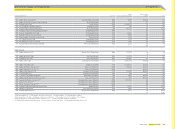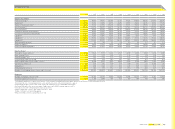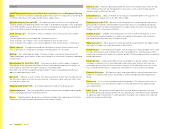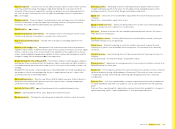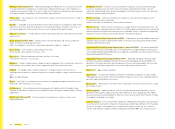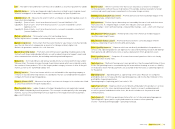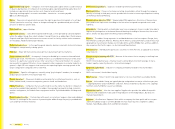Reebok 2008 Annual Report Download - page 216
Download and view the complete annual report
Please find page 216 of the 2008 Reebok annual report below. You can navigate through the pages in the report by either clicking on the pages listed below, or by using the keyword search tool below to find specific information within the annual report.
212 Appendix Glossary
Operating working capital Company’s short-term disposable capital which is used to fi nance
its day-to-day business. In comparison to working capital, operating working capital does not
include non-operational items such as cash, fi nancial assets and taxes.
Operating working capital = accounts receivable + inventories – accounts payable.
see also Working capital
Option Financial instrument which ensures the right to purchase (call option) or to sell (put
option) a particular asset (e.g. shares or foreign exchange) at a predetermined price (strike
price) on or before a specifi c date.
Order backlogs see Backlogs
Own-retail activities Sales directly generated through a store operated by a brand segment
within the adidas Group. Own retail includes Concept Stores (e.g. adidas Sport Performance,
Originals and Sport Style) and concession corners as well as factory outlets and e-commerce
for the adidas, Reebok and Rockport brands.
Performance business In the sporting goods industry, business related to technical footwear
and apparel, used primarily in doing sports.
PGA Tour Major US men’s professional golf tour, featuring 49 golf tournaments.
Price-earnings ratio (P/E) A company’s share price divided by its current or future diluted
earnings per share. The P/E ratio is used by investors as a fundamental measure of the attrac-
tiveness of a particular security versus other securities or the overall market. It is usually
more useful to compare P/E ratios of one company to other companies in a similar industry. In
general, a high P/E ratio suggests that investors are expecting higher earnings growth in the
future compared to companies with a lower P/E.
Price points Specifi c selling prices, normally using “psychological” numbers, for example a
product price of US $ 99.99 instead of US $ 100.
Private placement Placement of debt securities directly to institutional investors, such as
banks, mutual funds, insurance companies, pension funds and foundations.
Product licensees Companies that are authorised to use the name of a brand or company to
manufacture and distribute products. For adidas, these products primarily include cosmetics,
watches and eyewear, for Reebok fi tness equipment and for TaylorMade-adidas Golf bags and
gloves.
Promotion partnerships Partnerships with events, associations, leagues, clubs and individual
athletes. In exchange for the services of promoting the adidas Group, the party is provided with
cash and /or promotional material.
Promotional expenditure Expenses related to promotion partnerships.
Proxy solicitation Process of actively contacting shareholders, either through the company
directly or through a third-party service provider with the aim to increase participation in voting
at the Annual General Meeting.
Purchase price allocation (PPA) Stipulated by IFRS regulations. Allocation of the purchase
price paid for an acquisition according to the fair values assigned to acquired assets and
liabilities.
Record date Date by which a shareholder must own a company’s shares in order to be able to
register for participation in the Annual General Meeting. According to German law, the record
date is twenty-one days before the Annual General Meeting.
Regions The adidas Group segments its worldwide business into four regions: Europe, Asia,
North America and Latin America. Whereas North America and Latin America match the actual
geographical classifi cation, Europe also includes Africa and the Middle East, and Asia addition-
ally comprises the Pacifi c region, i.e. Australia and New Zealand.
Retail investor Individual who purchases securities for him-/herself, as opposed to an institu-
tional investor.
Return on capital employed (ROCE) Measure of the returns that a company is realising from
its capital.
ROCE = (income before taxes + fi nancial result + extraordinary income) / (average of share-
holders’ equity + minority interests + total net borrowings).
Return on equity (ROE) Indicator of company profi tability related to the shareholders’
fi nancing.
ROE = net income / shareholders’ equity.
Risk-free rate Rate of return to be expected on a risk-less investment, e.g. federal bonds.
Season At the adidas Group, we typically design and produce two major collections per year
– a Spring /Summer and a Fall / Winter collection. Hence, we divide our business into a Spring /
Summer and a Fall / Winter season accordingly.
Second tier supplier Also tier-two supplier. Supplier who provides the adidas Group with
materials and components to be used in the production of fi nished products, but does not
manufacture products.
Segment Also Business Segment. Units within a company that have profi t and loss respon-
sibility.The adidas Group is currently divided into four major business segments: adidas,
Reebok, TaylorMade-adidas Golf and HQ /Consolidation.



